-
Posts
53 -
Joined
-
Last visited
Posts posted by John Dipper
-
-
Hello Satomi, do get in touch with us.
Best wishes,
John
-
You could always phone us
-
Hello everyone,
I have been asked by a friend of dear (and much missed) Vernon Barrett, to post this, as he has no internet access. I am not taking any commission or any money for posting this, but I hope that this beautiful instrument can find a new home and continue to make music.
Vernon Barrett bought this very nice Wheatstone & Co McCann Duet in reasonable condition but in old philharmonic pitch and needing replacement bellows.
As he wanted a wooden ended instrument, we made new ends finished in beautiful Amboyna wood with hand cut fretwork and with new boxwood button stems with genuine Wheatstone gold plated button caps( new from Harry Minting's Wheatstone parts stock). New bellows in dark green goatskin were made by Rosalie Dipper.The instrument is now tuned in modern A=440 Hz pitch.The instrument has been very carefully looked after by Vernon for the last thirteen years or so and is in "as-new" condition.The Amboyna veneers used were the largest and only veneers we have ever had like this, and so the instrument really is one of a kind. Realistically, if we were to make an exact copy of this instrument then I can't really see that we could break even on costs if we charged much under £10,000. (I heard on the radio today, that you could only just afford a bottle of single malt whisky for the same price - I know what I would chose!) Sadly, there is not that much demand for Duets, so I guess the price will be less than that. If you are interested, please contact me.Best wishes to all, and happy squeezing,John -
We are confused, as we don't set up instruments with a 'heavy' action. The brass springs we use in Jeffries concertinas are actually lighter than the originals.
As always, we would ask you to contact us if there is an issue - maybe your friend could contact us directly, with a photo of the springs in question and we will be only too happy to help in any way we can. (If they are old springs, then it is best not to adjust them, but if they are new springs, we can instruct you on how to change their pressure).
-
Select results from this season:
Gigbag Strap Failure 4 - Your beautiful concertina 0
Fretwork Confetti 3 - Concert Appearance 0
Oh, I thought it would be safe 0 - Trashed Ends 2
Bent Buttons 1 - Gig Bag Happy 0
Total Rebuild 2 - Distresed Owner 0
Cut 'n Shut Superglue Bodge 0 - Gig Bag Complacency 2
Please, please, please don't, DON'T put your multi-thousand pound instrument in a picnic bag with a fancy badge and ideas above its station. Always use a proper, fitted case with blockings.
Remember, proper case forgetty: fretwork end confetti -
We've just been looking at our archives... Instrument No.117 has Paduk ends and was originally made for Captain George Sally. I remember that I got the day off school to travel up to London with mum and dad to deliver it in person while his Galleon, "The Godspeed" was at St Katherine's Dock.
Hope this is of use.
Very best wishes,
John
-
Hello,
Just to let you know, the first few details of performers are now up on my site www.johndipper.co.uk if you would like to be added then please PM me, or send me an e-mail via my site.
Very best wishes and happy to squeezing to all,
John
-
Seasons greetings to one and all.
I am in the process of making a website, and am hoping to do a page showing people who play our concertinas.
If you play a Dipper concertina, we would be delighted and very grateful if you could send us a photo of you playing it, and also a short paragraph about you and your music.
Wishing everyone a superb 2016 - I'd better get back to reed making - there might even be a whole hour off for lunch on Friday if the boss allows

-
Mal Derricott has asked me to post this article (below) that she has written about Rollo Woods being awarded and receiving an EFDSS Gold Badge. Rollo was incredibly generous with his knowledge when I interviewed him for my dissertation, concerning the pitch analysis of field recordings of Stephen Baldwin. (He was there at the recording, and was able to offer me incredibly useful background and information on exactly how it was done, the atmosphere and how he coaxed Mr Baldwin into letting us all hear him). Its fantastic to see Rollo being recognised for his many contributions to and work in the folk scene!
Rollo Woods – EFDSS Gold Badge Award
On Saturday 28th. November a very special party was held in Rollo’s home town of Swanage to celebration his award of the
Gold Badge of the English Folk Dance and Song Society. He is in very great company; Vaughan Williams received it too!200 people attended the celebration from many sections of the Folk society. The event began with a ‘Sing the Old Carols’workshop and some of the carols were mentioned by Thomas Hardy. Others were chosen for their particular link to the Purbeck area of Dorset. The carols chosen were Rollo’s favourites, or at least some of them as his repertoire is so vast it must have been very difficult for him to make a choice, and only 2 versions of ‘While Shepherds Watched’ out of a possible 400+!There followed a wonderful afternoon tea and then the main event; the formal presentation of the EFDSS Gold Badge Award.A long citation (although still an abbreviated version of the original text of 45 pages long) covering his lifetime of achievements involving Folk Music and Dance, was read out by Jack Crawford, the Chair of the West Gallery Music Association and then he presented Rollo with the Gold Badge on behalf of the English Folk and Dance Song Society.The celebration then continued with a family barn dance with caller Nigel Close (a long term friend of Rollo’s and band caller) leading Rollo’s current ceilidh band, Maiden Oak. We were also entertained by members of Rollo’s musical family. His grandson, Owen, a noted melodeon player, his son Tony and his daughter-in law, better known to jazz lovers than to folk enthusiasts. We were also surprised by a group of dancers from the local school who did 2 country dances and the Purbeck Mummers. It was an absolutely fantastic day and thoroughly enjoyed by all.Rollo is recognised today as a collector and researcher of West Gallery Music; but far more than that he is also a performer of this music, folk song and dance music and an inspiration to others to perform. He is also recognised widely amongst concertina players for his skilled playing and his enduring encouragement to all who play or aspire to play concertina.Rollo has that rare combination of the eye of an academic researcher combined with the active participation of a dancer and musician. Without performance the research could lie gathering dust on a bookshelf and what Rollo has done is ensure that this music is sung and played and above all, enjoyed.Rollo also represents in many ways the full range of activities of a Village Band member of Hardy’s day. He was an instigator and is now an Hon Vice President of the West Gallery Music Association. He was the founder, and is now the researcher and band leader for the Purbeck Village Quire and before that was a founder member of The Madding Crowd. In these groups he has championed the performance of Church music from the West Gallery era. But he is just as much at home as leader of his dance bands Maiden Oak and before that of Greenwood Tree and when in Hampshire, the Black Glove Band. As a dancer he was a member of the Cambridge Morris Men and later the Winchester Morris Men. This combination of West Gallery musician, dance band leader and Morris dancer is something very special and has been beneficial to all three areas.In all these roles Rollo has always been actively encouraging new talent and through that to ensure that the next generation will carry on singing dancing and making music!Mal DerricottPurbeck Village Quire -
Hello again,
I am running a series of Acoustic Creativity and Exploration workshop days with the superb multi-instrumentalist Emily Askew.
Each workshop day is aimed at all instrumentalists of intermediate and advanced level. Together, Emily and John have experience and expertise in strings, woodwind, free-reeds, and keyboards. We will help you to devise, create, develop and establish your own sound and approach to music making. We will look at:
• Identifying repertoire
• Adapting melodies to your needs
• Analysing stylistic features
• Developing a personal style and tone
• Making the tune your own
• Phrasing, Ornamentation and Improvisation
• Arranging music
• Performance skillsDates of Workshop Days:
October 11th 2015 GuildfordNovember 29th 2015 BristolJanuary 24th 2016 GuildfordMarch 20th 2016 BristolMay 22nd 2016 GuildfordPlease visit my website for more details: www.johndipper.co.uk
Like us on FaceBook: https://www.facebook.com/ACEworkshopDays
Follow us on Twitter: @ACEworkshopDays
John Dipper
A respected and established performer, composer and teacher and instrument maker, John grew up steeped in the traditions of Southern England. His unique playing style, and his compositions convey a deep understanding and passion for indigenous culture. As an experienced workshop leader and teacher, his knowledge, experience and enthusiasm combine to make him a much sought-after tutor in academic institutions including Goldsmiths, the Newcastle Folk Degree, Limerick University World Irish Music BA and MA courses, as well as at festivals and music-camps and academies. John has recorded on several film sound tracks including The Hobbit and is currently involved in several musical collaborations and projects including the English Acoustic Collective with Chris Wood, Alma, OSS and Patterson Dipper. John has recently started collaborating with superb guitarist and singer Dave Malkin, and the duo have been awarded an EFDSS residency at Cecil Sharp House for the Gravity Project looking at taking Morris Dance and Music in new directions, with the musicians helping the dancers defy gravity.
Emily Askew
Emily is a very versatile musician playing recorders, vielle (medieval fiddle), bagpipes, fiddle and piano. Her interests are wide and varied reaching from the deep roots of folk music through to Medieval, Baroque and contemporary repertoire. She is principal study recorder teacher at Trinity Laban, and as a member of the Askew Sisters, she has twice been a BBC Young Folk Award semi-finalist and in 2005. This year Emily was part of the EFDSS and Folk by the Oak project the Elizabethan Session and has started performing with the new fiddle band Alma. A keen chamber musician, Emily also performs with a range of early music ensembles. These include Medieval and Renaissance groups The Artisans and The Dufay Collective. Emily is also interested in opera and theatre. She has performed as principal recorder at Glyndebourne and as a multi-instrumentalist in productions for Apollo West End, Shakespeare's Globe Theatre, the Sam Wanamaker Playhouse -
Hello,
Just a quick shout out, that I will be one of the tutors, along with Tim Laycock, Brian Peters and Dave Townsend at concertinas at Witney on the 26th and 27th of September in Witney near Oxford.
Hope to see you there!
Very best,
John
www.johndipper,co.uk
http://www.davetownsendmusic.com/homweekends/concertinas.html
John Dipper is a leading member of the new generation of folk musicians, playing fiddle and concertina, performing with various groupings including Alma.
Tim Laycock is a well-established singer and concertina player, founder member of the New Scorpion Band, veteran of many stage productions at The National Theatre and elsewhere, and master of the Crane Duet.
Brian Peters has been performing and teaching traditional music and song all over the world for quite a while now, with anglo concertina and melodeon and occasional excursions into fiddle and guitar.
Dave Townsend is a singer and instrumentalist, playing accordion, fiddle and especially English concertina. His wide-ranging work covers performance, recording, research and publishing, including appearances on film, television and radio. He is the founder of The Mellstock Band and director of Hands On Music Weekends.
COURSE UNITS
Saturday Morning
A1 John Dipper - Creative Arrangement
How to create arrangements of tunes for concertinas, working at our own instant band arrangement. (All Systems, I/H)
A2 Tim Laycock - Exploring the Potential of the Duet for Harmony
It’s not as difficult as you think - Tim's comprehensive guide the possibilities of Duet concertinas. (All Duet systems, B/I)
A3 Brian Peters - Bonaparte’s Retreat
A selection of Napoleonic-themed tunes to commemorate the 200th anniversary of the Battle of Waterloo. (All Systems, B/I/H)
A4 Dave Townsend - Perfect Practice
As you snatch those precious minutes to practise your instrument, how do you make the best use of the time? And how do you avoid getting bored and lapsing into running over your favourite tunes? Dave will explain how to really improve your playing in an enjoyable way. (All Systems, B/I/H)
Saturday Afternoon
B1 John Dipper - Reinventing Tunes
How to make tunes your own so that they leap off the page! (All Systems, B/I/H)
B2 Tim Laycock - Dorset Tunes New and Old
Tunes from the Hardy and Rose Manuscripts, and one or two new Laycock compositions. (All Systems, B/I/H)
B3 Brian Peters - Anglo Harmony
All the way from the usual ‘vamp and chording’ left-hand style to the creation of moving harmony lines on Anglo concertina. (C/G Anglo, I/H)
B4 Dave Townsend - A Basic Guide to Harmony
A quick guide to how standard harmony works in the context of concertina playing. (All Systems, B/I/H)
Sunday
C1 John Dipper - ConcertinaTechniques
The whole gamut of techniques to improve your concertina playing, including bellows control, dynamics, rhythm and ornaments. (All Systems, B/I/H)
C2 Tim Laycock - Song Accompaniment
How to make your concertina accompaniments more effective. We’ll work on some examples together, and there will also be an opportunity for brave souls to play one of their own accompaniments to the group. (All Systems, B/I/H)
C3 Brian Peters - Rags to Riches
Ragtime tunes for concertina. You will need to know your way around the accidentals and odd corners of your instrument to get the most out of this unit - demanding and exhilarating! (All Systems, I/H)
C4 Dave Townsend - Sounding Brass
The classic concertina band repertoire of the early twentieth century came from the brass bands. We will play some of the classic brass band marches and other tunes which the old concertina bands used to play. Suitable for any concertina system, but good reading skills will be needed. Bass and Baritone English concertinas will be available on loan - they read from treble clef just like a standard treble. (I/H) -
Not much Wifi at Whitby - sorry for delayed reply.
Wolf; no the bellows are original on the Excelsior, with L-Pattern Lachenal papers.
Dick; the Edeophone has more buttons because it is a tenor-treble, and goes down to an octave below Middle-C, s as well as going as high as a standard treble.
Best wishes,
John
-
Hello,
I'm at Whitby Folk Festival all week, performing with James Patterson and then With Alma Fiddle band. I have three English concertinas with me that are for sale.
Tenor Edeopone - just restored by Colin Dipper. Lovely 1920's model, in modern pitch and with silver capped keys.
Excelsior - just renovated by Colin Dipper
Raised ended Wheatstone played by Ron Marks.
Please contact me for more details and prices.
I am also at Towersey Festival on Sunday as well.
-
I'd be very happy to teach you via FaceTime or Skype.
PM me.
Best wishes,
John
-
Geoff is a fine upstanding member of this community and an Innocent bystander in this torrid affair. While you sir, may be suffering from Spring fever!
-
(See attached image) A quick plea from the C & R Dipper & Son concertina workshop:
Who ever is 'wonking' these springs and ruining them in the delightful misbelief that a super-light action won't leak, will you please stop!
This is the second instrument we have had in recently, where almost all the springs which were in perfectly good condition, will now need to be replaced, due to the spring-wonker's antics!
-
I know!

My bedtime stories were all about dampers, sampers and woggles, and if I'd been very naughty, then it was tales of the Daemon-Woggler, to scare me!
-
You might like to have a look at:
http://www.concertina.info/tina.faq/images/dipp.htm
Showing dad playing a Dipper 'Franglo'.
Lachenal, Jones and Crabb all made concertinas with the buttons laid out like a piano, to tempt people into the world of Squeezing!
In the 1850s Wheatstone also experimented with a chromatic system, somewhere close to the French accordion systems.
We have also made two concertinas in the 3-row French Chromatic system for Thomas Restoin.
Right, best get back to fitting and profiling reeds, or the master will dock my pay!
-
Over the years we have made several McCann and Crane duets and at least ten Hayden duets, all using traditional construction methods. The instruments are very expensive to make and the complexities of playing other than melody lines not always considered by purchasers. We reckon anything over a 58 button will mean a struggle for the player - at worst a struggle for the listener! Comparisons with getting an oil tanker to change direction may be made...
We have made numbers of diatonic accordion system concertinas and recently two Chromatic accordion system duets. (Try listening to Thomas Restoin to understand the possibilities of the Chromatic duet).
The best duet playing on a small 46 McCann is in my experience that of John Morgan of Ogmore Vale. Valuable lessons lessons in managing the larger duets can be learned from Iris Bishop. Try also the playing on "Eloise" by Ralphie Jordan - who will be sadly missed.
-
The Concertina connection here is via Joseph Scates, the ex-Wheatstone craftsman. From 1851 he operated in Dublin as a professor of music, and from 1853 as a designer, patentee and maker of concertinas at 26 or 27 College Green Dublin, very near to the Parnormo and William Gibson string instrument makers. He moved to Westmorland street and finally sold the operation to Cramer&Co in 1865
-
Our workshop experience tells us that the damage described above can ONLY be from an impact. Note that only one side is affected. The levers being bent will have been caused by the corresponding buttons being depressed on impact. None of this is weather related.
We understand that this particular instrument has gone through massive changes in humidity in its relatively short life, but this is all within our design parameters. We have been able to rescue and restore to full working order, several of our instruments that have met with disaster. One that spent a week submersed in a flooded cellar, one that was beneath a burst water pipe in another cellar, one that was used in a paddling pool as a posh super-soaker (presumably the child in question will be removed from the will), one that was driven over by a car, and one that was attacked by a jealous wife with a bread knife!
We have sadly seen instruments that have had botched (4 tubes of Epoxy) repairs that have meant that a proper repair was impossible (even though it could have been returned to perfect condition had the botch not been perpetrated).
It is essential that anyone with a problem get in touch IMMEDIATELY with the relevant maker BEFORE reaching for Gloy, Prittstick, superglue, Araldite, PVA or the internet.
We are delighted to hear about the lives of our mechanical creations, wayward or well behaved.
We would advise:
1. A case is your first line of insurance. ALWAYS use a hard case with properly fitted blockings to protect the fretwork and mechanism. You never see a violin carried round in gig bag - why on earth chance your concertina to other people's clumsiness!?
1b. It would seem cellars are not good places to leave concertinas.
2. Contact the maker as soon as you realise your concertina has suffered a catastrophe!
3. Don't get happy with the glue - or it may be "Game Over" for Tommy Tina!
4. If you don't get any joy from the relevant maker, then ask for help on here.
A very Happy New Year and joyful squeezing to all,
John
-
A very interesting topic that begs several questions to be asked...
Chris, I'd be very interested to know if the microphone was pointing directly at the end of the concertina? In my experience, there are many times when I'll be sitting at the tuning bench and dad will be standing next to me (stealing my screwdriver to put an instrument together), and when he plays it, my ear is at the same level as the end, and receives a VERY piercing sound. However, as soon as I am off axis, the sound mellows incredibly.
It would be interesting to consider repeating the test with the microphone pointing at the instrument but without the diaphragm of the microphone being aligned with the end plate (wooden or metal) of the concertina.
Further to this, no-one who plays a concertina would ever be able to listen to both ends at once in this way (a nasty case of severe 'Wimbledon Umpire's Neck' would occur)! Interesting to read Robin's observations about playing close to a window. For sure the window needs to be removed - it's only -35 C - Man Up!!! ;-) Seriously though, many fiddlers and violinists I know will have a specially fitted earplug with a constant 10dB reduction across the hearing range for their left ear (closest to the fiddle) and I quite often practice with earbuds in.
While recording with Rob Harbron we ended up using a single microphone in front of the instrument, as this gave the most natural sound. (Before this Rob had always put a mic on each side of the instrument, and the sound from his wooden ended Wheatstone was quite full of harmonics that we all associate with metal ends).
I've recently been experimenting with Mid/Side recording, which on my fiddle gives a great sound. For the concertina I have rotated the mic array through 90 degrees so that the mic placement is more like Mid/TopBottom so that the English does not produce the Haas effect. (The microphones being in front of the instrument between 12" - 18" away).
My experience of live sound tells me that the average sound engineer doesn't know NOT to pan the sides of an English concertina hard left and hard right, and also for simplicity, one microphone actually works superbly and gives a far more natural sound.
I''m encouraged that people posting on here understand that the point of well fitted reeds and careful acoustic design mean that an instrument can be incredibly loud, but they don't have to be payed at the volume. A Stradivarius is designed to fill a concert hall and let the people in the back row hear the soloist over the orchestra, but that does not mean its played to the max all the time. There sadly seems to be a small contingent of players out there that have chosen to adopt the baboon method of playing assuming that bent and forced out of tune notes is the aim, and that volume is the be all and end all. We are constantly striving to create instruments that allow the maximum possible transfer of the players intentions and emotions, and its sad when you hear an instrument that is only ever played at 11. Music seems very much to me to be linked to speech and song - if you've ever tried to converse with someone who only shouts its very boring ;-). It's also quite like buying a Ferrari or Aston Martin and complaining that when you drive it at 200mph into the car park it's really hard to park it in the space!
Sorry, I've probably strayed way off topic, but what I am trying to say is, the listening or mic'ing position/axis is an important factor. So is the volume/intensity of the note (how much pressure the player applies) for sure this will change the harmonic complexity of the note.
Right, best get back to the Reedpans I was making...
Hail the land of wonderful adventures, fiddling, tweaking and head-scratching as the waiting list increases... !
-
I'm happy to say that this beautiful Shakespeare with its engraved ends and lighting fast reeds has gone to a young musician in Ireland via a friend.
-
Hello,
I'm doing some teaching on the MA Irish Traditional Music Performance at the Irish World Academy of Music and Dance in Limerick this Monday, Tuesday and Wednesday morning. I will have with me a 28 key C/G Shakespeare which I have renovated under dads exacting standards. It has engraved ends, a new action, new Dipper bellows with authentic gold tooling, is now tuned to A=440 and dad reckons its a corker, and would be especially good for a child due to its small size.
If you would like to have a play on it then please phone or text my Mobile +447980 917 449 as I'm not sure I'll be able to get access to Concertina.net or e-mail while I am there. Preferably text - as roaming charges seem to be extortionate!!!)
Looking forward to great music and craic!
John


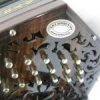
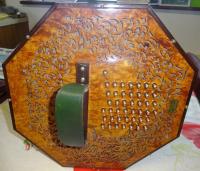
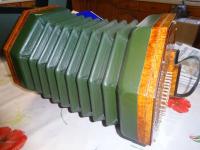
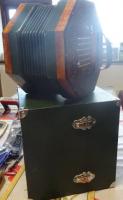
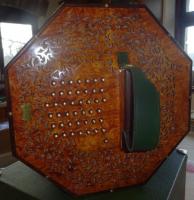
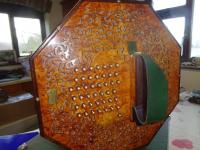
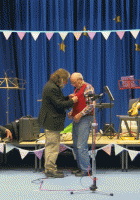
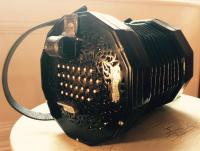
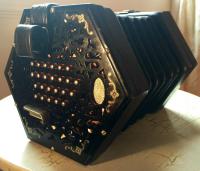
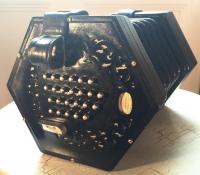
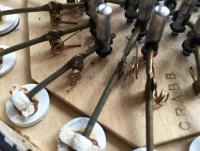

Concertina Playgroup - Softplay
in General Concertina Discussion
Posted · Edited by John Dipper
Just a quick message from Rosalie,
lesoncontinu at Chateau d’Ars July 12 - 15 2018
All known or suspected concertina players are most cordially invited to join us for a
Concertina Playgroup - probably at 3pm on Friday 13.
Enquire chez Pierrot Accordeons for more information
Don't forget your instrument! All systems and abilities welcome